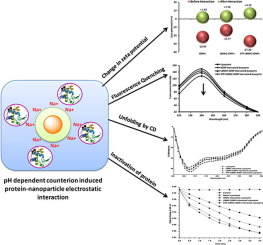Bioorganic Chemistry ( IF 4.5 ) Pub Date : 2018-09-15 , DOI: 10.1016/j.bioorg.2018.09.020 Sathish Dyawanapelly , Pihu Mehrotra , Goutam Ghosh , Dhanashree D Jagtap , Prajakta Dandekar , Ratnesh Jain

|
To understand the effect of counter ions (Na+) on the secondary conformation and functionality of the lysozyme, we have studied the interaction of lysozyme with counterion associated iron oxide nanoparticles (IONPs). The investigation was carried out at pH 7.4 and 9.0, with three different types of NPs, namely, bare IONPs, low molecular weight chitosan modified IONPs (LMWC-IONPs) and the counterion (Na+) associated sodium tripolyphosphate IONPs (STP-LMWC-IONPs) and confirmed by using various spectroscopy techniques. The difference in UV–vis absorbance (ΔA) between native and STP-LMWC-IONPs interacted hen egg white lysozyme (HEWL) was greater than that between native and NPs interacted HEWL at pH 9.0 compared with pH 7.4. Furthermore, STP-LMWC-IONPs exhibited quenching effect on lysozyme fluorescence spectrum at pH 9.0 due to binding of Na+ counterions to the protein, confirming denaturation of the latter. After HEWL interaction with STP-LMWC-IONPs (pH 9.0), CD spectra revealed a conformational change in the secondary structure of HEWL. Also, counterion induced lysozyme inactivation, due to interaction with nanoparticles at pH 9.0, was confirmed by enzymatic activity assay involving lysis of Micrococcus lysodeikticus. In conclusion, pH 9.0 was observed to be a more favorable condition, compared to pH 7.4, for the strongest electrostatic interaction between lysozyme and NPs. We postulate that the counterions in nanoparticle surface-coating can ameliorate protein misfolding or unfolding and also prevent their aggregation and, therefore, can be considered as a powerful and potential therapeutic strategy to treat incurable neurodegenerative disorders.
中文翻译:

表面功能化的纳米粒子如何影响蛋白质的构象和活性:通过蛋白质-纳米粒子的相互作用进行探索
为了了解抗衡离子(Na +)对溶菌酶的二级构象和功能的影响,我们研究了溶菌酶与抗衡离子相关的氧化铁纳米颗粒(IONPs)的相互作用。研究是在pH 7.4和9.0的条件下,用三种不同类型的NP进行的,分别是裸IONP,低分子量壳聚糖修饰的IONP(LMWC-IONP)和抗衡离子(Na +)相关的三聚磷酸钠IONP(STP-LMWC-IONPs),并通过使用各种光谱技术进行了确认。在pH 9.0时,天然蛋白和STP-LMWC-IONPs相互作用的蛋清溶菌酶(HEWL)之间的紫外可见吸收(ΔA)差异大于在pH 9.0时,天然蛋白和NPs相互作用的HEWL之间的差异。此外,由于Na +抗衡离子与蛋白质结合,STP-LMWC-IONPs在pH 9.0时对溶菌酶荧光光谱表现出猝灭作用,从而证实了蛋白质的变性。HEWL与STP-LMWC-IONPs(pH 9.0)相互作用后,CD光谱显示HEWL的二级结构发生构象变化。同样,由于抗衡离子诱导的溶菌酶失活,是由于与pH 9.0的纳米颗粒发生了相互作用,这一结果已通过酶活性测定(包括溶菌酶的裂解)得以证实。微小球菌lysodeikticus。总之,与溶质酶和NP之间最强的静电相互作用相比,pH 9.0被认为是比pH 7.4更有利的条件。我们假设纳米粒子表面涂层中的抗衡离子可以改善蛋白质的错误折叠或展开,并防止其聚集,因此,可以将其视为治疗顽固性神经退行性疾病的有力且潜在的治疗策略。











































 京公网安备 11010802027423号
京公网安备 11010802027423号